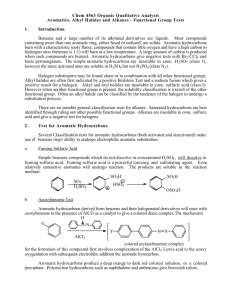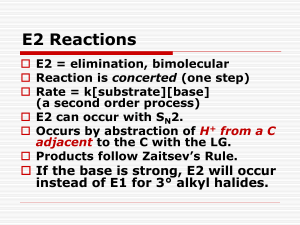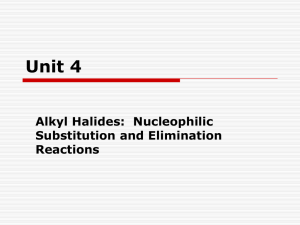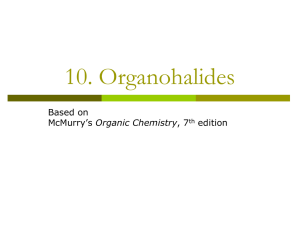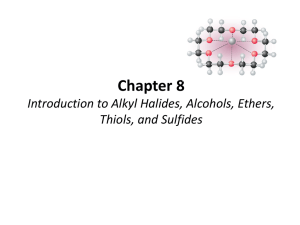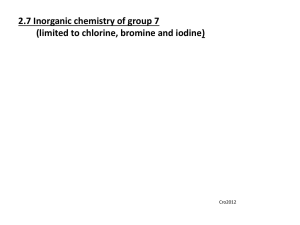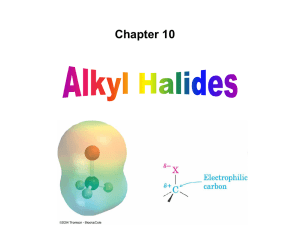Alkyl Halide Classification Tests
advertisement
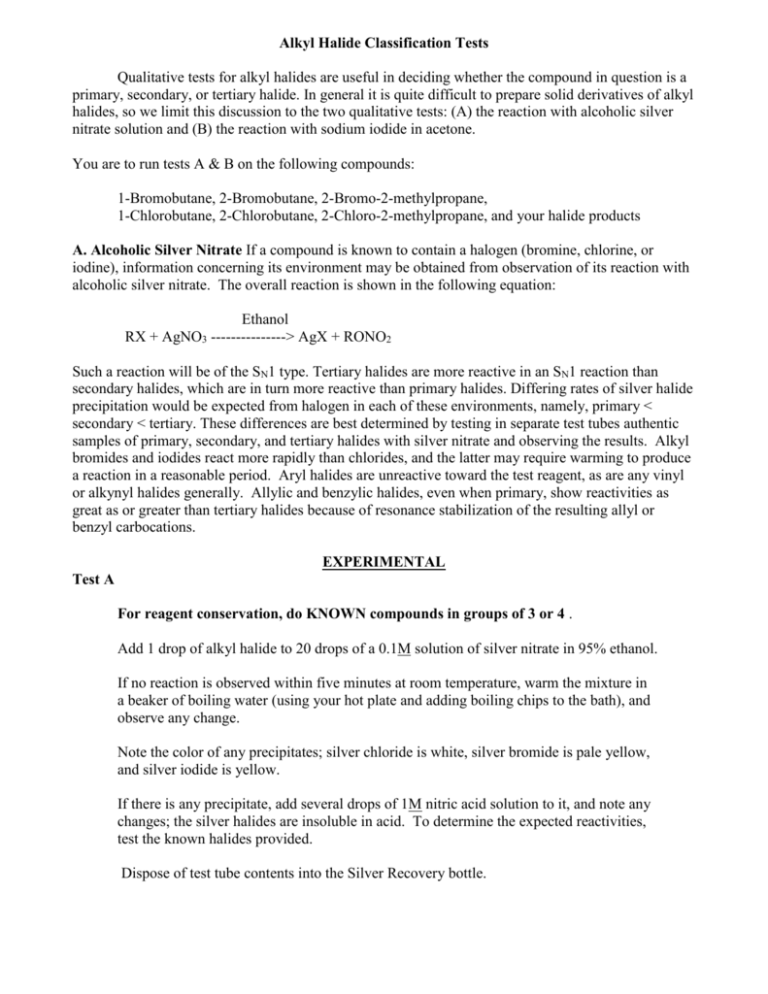
Alkyl Halide Classification Tests Qualitative tests for alkyl halides are useful in deciding whether the compound in question is a primary, secondary, or tertiary halide. In general it is quite difficult to prepare solid derivatives of alkyl halides, so we limit this discussion to the two qualitative tests: (A) the reaction with alcoholic silver nitrate solution and (B) the reaction with sodium iodide in acetone. You are to run tests A & B on the following compounds: 1-Bromobutane, 2-Bromobutane, 2-Bromo-2-methylpropane, 1-Chlorobutane, 2-Chlorobutane, 2-Chloro-2-methylpropane, and your halide products A. Alcoholic Silver Nitrate If a compound is known to contain a halogen (bromine, chlorine, or iodine), information concerning its environment may be obtained from observation of its reaction with alcoholic silver nitrate. The overall reaction is shown in the following equation: Ethanol RX + AgNO3 ---------------> AgX + RONO2 Such a reaction will be of the SN1 type. Tertiary halides are more reactive in an SN1 reaction than secondary halides, which are in turn more reactive than primary halides. Differing rates of silver halide precipitation would be expected from halogen in each of these environments, namely, primary < secondary < tertiary. These differences are best determined by testing in separate test tubes authentic samples of primary, secondary, and tertiary halides with silver nitrate and observing the results. Alkyl bromides and iodides react more rapidly than chlorides, and the latter may require warming to produce a reaction in a reasonable period. Aryl halides are unreactive toward the test reagent, as are any vinyl or alkynyl halides generally. Allylic and benzylic halides, even when primary, show reactivities as great as or greater than tertiary halides because of resonance stabilization of the resulting allyl or benzyl carbocations. EXPERIMENTAL Test A For reagent conservation, do KNOWN compounds in groups of 3 or 4 . Add 1 drop of alkyl halide to 20 drops of a 0.1M solution of silver nitrate in 95% ethanol. If no reaction is observed within five minutes at room temperature, warm the mixture in a beaker of boiling water (using your hot plate and adding boiling chips to the bath), and observe any change. Note the color of any precipitates; silver chloride is white, silver bromide is pale yellow, and silver iodide is yellow. If there is any precipitate, add several drops of 1M nitric acid solution to it, and note any changes; the silver halides are insoluble in acid. To determine the expected reactivities, test the known halides provided. Dispose of test tube contents into the Silver Recovery bottle. B. Sodium iodide in Acetone Another method for distinguishing between primary secondary, and tertiary halides makes use of sodium iodide dissolved in acetone. This test complements the alcoholic silver nitrate test, and when these two tests are used together, is possible to determine fairly accurately the gross structure of the attached alkyl group. The test depends on the fact that both sodium chloride and sodium bromide are not very soluble in acetone, whereas sodium iodide is. The reactions that occur are SN2 substitutions in which iodide ion is the nucleophile; the order of reactivity is primary > secondary > tertiary. acetone RCl + NaI ------------> RI + NaCl acetone RBr + NaI ------------> RI + NaBr With the reagent, primary bromides give a precipitate of sodium bromide in about 3 min at room temperature, whereas the primary and secondary chlorides must be heated to about 50C before reaction occurs. Secondary and tertiary bromides react at 50C, but the tertiary chlorides fail to react in a reasonable time. It should be noted that this test is necessarily limited to bromides and chlorides. EXPERIMENTAL Test B For reagent conservation, do KNOWN compounds in groups of 3 or 4 . Place 20 drops of the sodium iodide in acetone test solution in a test tube, and add 2 drops of the chloro or bromo compound. Cover and shake the test tube. Allow the tube to stand for 3 minutes and observe the formation of any precipitate. If no precipitate has formed, heat the tube in a bath of 50oC water (hot plate) for 6 minutes, then allow it to cool to room temperature. If a precipitate has formed, shake the contents of the tube. If the precipitate is still present after shaking the test tube and allowing it to stand at room temperature for 3 minutes, the test is positive. Carry this reaction out on all bromide and chloride samples provided, including your products. Note in all cases the differences in reactivity as evidenced by the rate of formation of sodium bromide or chloride. Dispose of test tube contents into the Recovered Organic Solvents bottle. Che 301 Su’2003 Lab Report Title: Alkyl Halide Classification Tests Name: Date: Test: Alcoholic AgNO3 Equation: What indicates a positive test: How can the halides be distinguished from one another ? Known Halides Results / Observations 1-Bromobutane 1-Chlorobutane 2-Bromobutane 2-Chlorobutane 2-Bromo-2-methylpropane 2-Chloro-2-methylpropane Products Results / Observations 1-Bromobutane 2-Chloro-2-methylbutane Conclusions: Your 1-Bromobutane behaved similarly to which known(s) ? Your t-Butylchloride behaved similarly to which known(s) ? Test: NaI in Acetone Equation: What indicates a positive test: How can the halides be distinguished from one another ? Known Halides Results / Observations 1-Bromobutane 1-Chlorobutane 2-Bromobutane 2-Chlorobutane 2-Bromo-2-methylpropane 2-Chloro-2-methylpropane Products Results / Observations 1-Bromobutane 2-Chloro-2-methylbutane Conclusions: Your 1-Bromobutane behaved similarly to which known(s) ? Your t-Butylchloride behaved similarly to which known(s) ?

